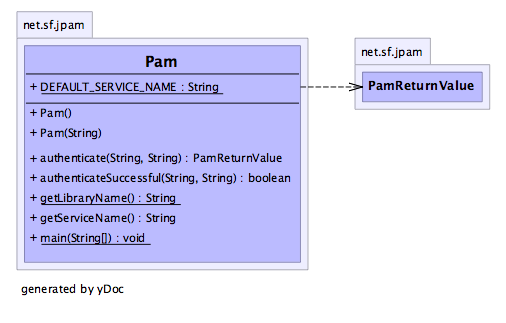

Attempt to authenticate a username and password
String user1Name = "test";
String user1Credentials = "testPassword";
Pam pam = new Pam();
boolean authenticated = pam.authenticateSuccessful(user1Name, user1Credentials));

Shows how to use the JAAS API together with a CallbackHandler.
LoginContext loginContext = new LoginContext("net-sf-jpam", new JpamCallbackHandler());
loginContext.login();
loginContext.login();
/**
* The application must implement the CallbackHandler.
* <p/>
* <p> This application is text-based. Therefore it displays information
* to the user using the OutputStreams System.out and System.err,
* and gathers input from the user using the InputStream, System.in.
*/
class JpamCallbackHandler implements CallbackHandler {
/**
* Invoke an array of Callbacks.
* <p/>
* <p/>
*
* @param callbacks an array of <code>Callback</code> objects which contain
* the information requested by an underlying security
* service to be retrieved or displayed.
* @throws java.io.IOException if an input or output error occurs. <p>
* @throws UnsupportedCallbackException if the implementation of this
* method does not support one or more of the Callbacks
* specified in the <code>callbacks</code> parameter.
*/
public void handle(Callback[] callbacks)
throws IOException, UnsupportedCallbackException {
for (int i = 0; i < callbacks.length; i++) {
if (callbacks[i] instanceof TextOutputCallback) {
// display the message according to the specified type
TextOutputCallback toc = (TextOutputCallback) callbacks[i];
switch (toc.getMessageType()) {
case TextOutputCallback.INFORMATION:
System.out.println(toc.getMessage());
break;
case TextOutputCallback.ERROR:
System.out.println("ERROR: " + toc.getMessage());
break;
case TextOutputCallback.WARNING:
System.out.println("WARNING: " + toc.getMessage());
break;
default:
throw new IOException("Unsupported message type: "
+ toc.getMessageType());
}
} else if (callbacks[i] instanceof NameCallback) {
// prompt the user for a username
NameCallback nc = (NameCallback) callbacks[i];
nc.setName(user1Name);
} else if (callbacks[i] instanceof PasswordCallback) {
// prompt the user for sensitive information
PasswordCallback pc = (PasswordCallback) callbacks[i];
pc.setPassword(callbackCredentials.toCharArray());
} else {
throw new UnsupportedCallbackException
(callbacks[i], "Unrecognized Callback");
}
}
}
}
JPam comes with a comprehensive JUnit test suite, which not only tests the code, but shows you how to use JPam.
A link to browsable unit test source code for the major JPam classes is given per section. The unit tests are also in the src.zip in the JPam tarball.